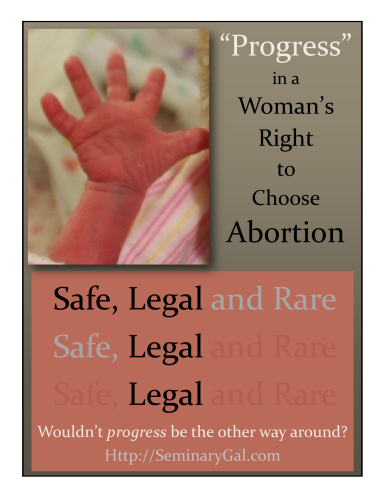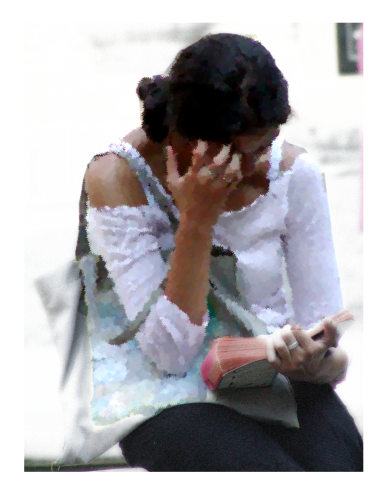With the recent federal judge’s approval (and the Obama administration’s assent) regarding Plan B being now available without a prescription to “women” of all ages, we’ve entered a new front on a Woman’s Right to Choose Abortion. Has progress in reproductive health really been made? I submit to you it’s not progress at all. Read on for my reasons why I believe Plan B–as an emergency contraceptive–is a prescription for child endangerment.

It’s not progress on a Woman’s Right to Choose Abortion or reproductive health for 2 primary reasons: (1) progress means something and (2) women need to be distinguished from children by virtue of maturity, not just development.
Progress Means Something
First, progress is a word that means something. Most definitions refer to it as being a gradual development or advance toward a higher standard, purpose, or goal. It also refers to a social movement in favor of greater civilization. Would you say that abortion is a higher standard, purpose, or goal…or that such reproductive choices are a beautiful hallmark of more civilized countries?
Consider that a Woman’s Right to Choose Abortion has gone from unsafe, illegal back alleys to Gosnell-style clinics where a woman is unsafe and late term abortions are illegally performed in clinics that are hardly more sanitary than “back alleys.” Where is the progress?
Oh, that’s where Plan B comes in, you say. If women had access to Plan B, they wouldn’t need to have abortions.
That’s certainly the sales pitch. It is touted as safe and now legal, but how rare will it really be? Not at all, excepting the prohibitive cost, until the Affordable Care Act makes it necessary for “reproductive health” and nothing more than birth control that the taxpayers will ultimately cover. How safe it is depends on the user since no doctor, parent, adult, or pharmacist is going to read the instruction booklet to the child user and oversee the drug’s use. Given the reading level of the average 10 year-old (and many adults living in poverty), the jury’s out regarding its safety.
But let’s look at reality: women and children (which is what 10 year olds are) don’t plan ahead. If they did, there have been free condoms available for years that also minimize STDs that Plan B does nothing about. Have we made progress in the planning ahead? Nope.
Frankly, sexually active 10 year olds would not be a characteristic of developed countries with higher education. They are more likely to be found in developing countries where women don’t have access to education. We’ve had “sex ed” in American public schools for decades. Has this education done no good? Our culture has decried abstinence education as unrealistic so we’ve taught kids how to use birth control so ostensibly they can plan ahead.
Has our education system informed students in a way that reflects progress toward safe sex and birth control? Have we made any progress at all in educating women and pre-teens?
Adultification of Children
This brings me to my second point: In American culture we are encouraging adultification of children and the youthification of adults. Children, unsuited to making adult decisions because they are children, are yet being expected to grow up faster, become sexualized sooner, and to take responsibility for taking Plan B, for example, without any adult help. On the other hand, we have the youthification of the adult in which adults refuse to accept adult responsibilities for their actions. Adults ought to be intellectually developed enough to see that intercourse can lead to pregnancy and STDs. They’ve been taught that since middle school. They ought to be able to plan ahead (whether through abstinence or birth control as their personally held values might allow). Children less so.
This is not just a concern for Christians such as myself who believe that God established parents as the ones responsible for raising children within the family. Christians are also taught to look out for the welfare of the vulnerable and to help them, not take advantage of them.
The American Psychological Association (APA) published a study in 2007 entitled, “Report of the APA Task Force on the Sexualization of Girls” in which they identify four problem areas:
These examples illustrate different aspects of our definition of sexualization. In the first example, we are concerned with the imbuing of adult sexuality upon a child. In the second, we are reminded that a specific and virtually unattainable physical appearance constitutes sexiness for women and girls in our society. In the third, we see that sexuality is valued over other more relevant characteristics…the girls are being sexually objectified. In the fourth example, the adult models are sexually objectified and the distinction between adults and children is blurred, thus sexualizing girlhood.
The authors write as the foundation for necessity of this Task Force study,
Sexualization may be especially problematic when it happens to youth…Indeed Tolman (2002) argued that in the current environment, teen girls are encouraged to look sexy, yet they know little about what it means to be sexual, to have sexual desires, and to make rational and responsible decisions about pleasure and risk within intimate relationships…Younger girls imbued with adult sexuality may seem sexually appealing and this may suggest their sexual availability and status as appropriate sexual objects. Concomitantly, women are often considered sexy only when they appear young, thus blurring the line between who is and is not sexually mature (Cook & Kaiser, 2004).
Their concern–as all of ours should be–is that children are ill-equipped to make adult decisions. Their stage of maturation is that of a child and yet, they are being seduced by our media culture, adults, and their equally immature peers into engaging in adult behaviors without adult discerning capabilities. The result of these influences may be that a child’s mind is insufficiently mature enough to make both responsible and rational responses…both in terms of consent and in terms of consequences. The development of responsible reasoning doesn’t keep equal pace to biological possibilities presented by early physical maturation and cultural seduction.
In some cases, adults are abusing children in which case there are two problems, the abuse and the cover-up by a Plan B approach. But in other cases, children are mimicking what they see in the media and find themselves unprepared for pregnancy (so often exalted in the magazines among their idols) when they lack a starlet’s income and glamour-power to make the baby bump desirable in the eyes of society.
Add to that, there is an issue of a pre-teen’s educational level and ability to research, read, and understand Plan B instructions (since the products are packaged and instructed for someone over the age of consent). In spite of a lack of understanding regarding what they are doing, there is a great temptation to select an easy fix to a situation they do not want to be in and end up putting their bodies in further danger either now or in the future.
 In fact, the manufacturer’s web site is not age appropriate reading for 10 year olds according to the same Flesch-Kincaid reading ease assessments used by the Department of Defense.
In fact, the manufacturer’s web site is not age appropriate reading for 10 year olds according to the same Flesch-Kincaid reading ease assessments used by the Department of Defense.
- An 8th grade reading level is for the manufacturer’s Home Page,
- However, the When To Take and When Not to Take segments that tell a young girl how to take Plan B are harder to read with understanding, scoring at a reading level of 9.6. That’s a freshman to sophomore in high school level. But it gets more interesting,
- The Side Effects–which are really important to know if the disclaimers on every TV ad are any indication–read at a grade level of 11.4 (that’s nearly graduating from high school).
- Wait, it gets worse. In the section explaining How Can You Tell If It’s Worked, the manufacturer’s description has a reading ease grade level of 16.6 (College Graduate and above).
Really now, is this something that a 10 year old is going to understand?
This demand upon children is unconscionable, apart from some kind of parental consent/notification requirement. To think that a child ought to ingest something that they can’t even read about at their grade level…or understand.. and yet expect it will be taken according to how the manufacturer designed and tested its safety is an unreasonable expectation.
And of course, that’s if the child is willing to take a medication as directed.
How many of us know kids who think more of something is automatically better?
Why are we not using the same standard that public schools require for over the counter meds?
The public school nurse won’t even allow any 10-12 year old to monitor her own Midol usage.
I can understand that a judge doesn’t want to be in a position of telling a 12 year old she can be on the adult donor list for an organ, but not on the adult list when it comes to getting out of a jam regarding pregnancy. However, for surgeries, hospitals require that adults need to consent for minors and children will need their parents for the insurance. For Plan B, part of what is disturbing about this is that children are placed in a position in which it may be legal, but Plan B may be utilized in place of safer forms of birth control for routine usage. The untested long-term effects of this on children render Plan B as neither safe nor rare even if it is legal.
In what way is any woman liberated by the sexualization of a child?
With respect to A Woman’s Right to Choose Abortion or a child’s reproductive health, has there been genuine progress made?
To recede from something that was sold as needing to be Safe, Legal, and Rare to something that now is merely Legal is not evidence of progress to me. Add to that the regression regarding age standards for purchasing pharmaceuticals such as Plan B by children who cannot understand what they are taking is irresponsible. Furthermore, it makes the ongoing sexualization of children a mercenary endeavor by pro-abortion activists and pharmaceutical suppliers.
Wouldn’t genuine progress be the other way around, looking out for our young girls as the higher goal of a civilized society?